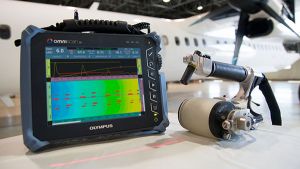FAQs
Frequently Asked Questions
Can the RollerFORM scanner be used for applications other than aerospace or wind blade inspection? |
Can the RollerFORM inspect honeycomb panels?
The RollerFORM scanner can detect defects in the volume of CFRP skin that is 2 to 50 mm thick. It can also be used for near-side detection of disbonding between CFRP layers (thicker than 2 mm) and honeycomb structures for certain material combinations. However, the BondMaster bond tester remains the recommended method for disbond detection between CFRP and honeycomb and for delamination detection in CFRP layers thinner than 2 mm.
Can the RollerFORM be used for corrosion mapping inspection?
Yes. Even though the HydroFORM scanner remains the ideal choice for corrosion inspection, the RollerFORM scanner is a suitable option for corrosion applications that do not require optimum near-surface resolution (NSR) or high frequencies. Furthermore, the RollerFORM scanner can be particularly useful for quick checkups or when performing strip inspections on the longitudinal axis of pipes that are 4 in. OD or greater. The RollerFORM scanner has a 3 mm NSR in steel (as opposed to 1.5 mm for the HydroFORM) and has a maximum frequency of 5 MHz. The HydroFORM is also better suited for integration with full 2-D mapping scanners.
